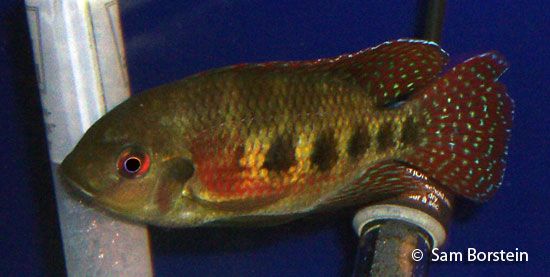'Tilapia' mariae
Boulenger, 1899
Mangrove Tilapia, Spotted Tilapia

Above: A male Tilapia mariae. Photo by Sam Borstein.
Etymology:
Genus- Tilapia= African for fish (Bechuana).
Species- mariae= Named after the collector Mary Kingsley.
Intro:
'Tilapia' mariae is a large growing West African cichlid that doesn't have the best reputation. This fish, first typed by Boulenger in 1899, is a highly invasive species around the world and especially in the southern United States.
This is a large and pretty fish. When young the fish are striped and as they get older the stripes turn into dots. The fish also obtain a gold hue and a red breast.
The Spotted Tilapia is a substrate spawner like the other fish of the genus. This fish is aggressive, but is resilient and can handle almost any water condition.
Recent phylogenetic studies have found Tilapia to be paraphyletic and it is almost certain that generic status of'Tilapia' mariae will change (Lamboj, 2004). Most likely the subgenus Pelmatolapia, which 'Tilapia' mariae belongs to, will be raised to a full generic status.
Distribution:
'Tilapia' mariae is naturally found in Cameroon and Nigeria in brackish water mangrove swamps by the coast. This species is known to occur in pure saltwater of the coast and even breed under these conditions.
This fish has been a nuisance species in the United States for at least a decade, most notably in Florida, but according to the U.S. Geological Survey also occurs in Arizona and part of Nevada.
Size, Maturity, and Sexual Dimorphism:
Size: Males- 14 inches, Females- 12 inches.
Maturity: 3.5 inches
Sexual Dimorphism: Males are larger. Females have a great amount of red in their stomachs and chest, which is quite noticeable during spawning.
Care:
'Tilapia' mariae can be difficult to care for because it is large and is very aggressive. A 6 foot tank is needed unless you have worked with a specific pair with a good pair bond, in which case a smaller tank could be used.
Aggression seems to be directed only towards members of the same species, although when breeding the fish become intolerant of any other fish.
Like said above, the fish are aggressive, so decorate the tank with plenty of hiding places. The fish also create a lot of waste so you need to do weekly water changes.
As far as tankmates, Central American cichlids have very similar requirments and aggression levels, making them ideal candidates.
Diet:
I fed a variety of foods such as Dainichi Veggie Deluxe, Tetra Cichlid Sticks, and New Life Spectrum. They are a Tilapia, so they will eat just about anything.
Breeding:
In my opinion, the fish take quite a while to pair up and then after a pair forms, even longer to breed. There seems to be a long courting period. The fish generally pick a flower pot or tube and make a nest out of it. Up to 2,000 eggs can be laid by large fish. Mine laid eggs in a flower pot. These eggs are guarded voraciously by the parents. Other fish are at risk of death at this time, so monitor behavior carefully.
The fry hatch in a few days and are free swimming in 8-9 days depending on temperature. The parents guard them ferociously.
Raising the free is easy. Although they are tiny, they can eat flake from the start, but do much better on baby brine shrimp. By one month the fish are at least an inch in length.
Conclusion:
This is a nice West African to keep. Before you get it, check your local and state laws to see if it may be illegal to keep this species, especially if you live in a warmer, southern climate. This fish is a hobbyist fish and may be dificult to find. It's a good species to keep if you like Central American cichlids.
References:
- Boulenger, G.A. (1899) A revision of the African and Syrian fishes of the family Cichlidae. Part II; Proceedings of the Zoological Society of London, 98-143.
- Lamboj, A. (2004). The Cichlid Fishes of Western Africa. Bergit Schmettkamp Verlag, Bornheim, Germany, 255 pp.
